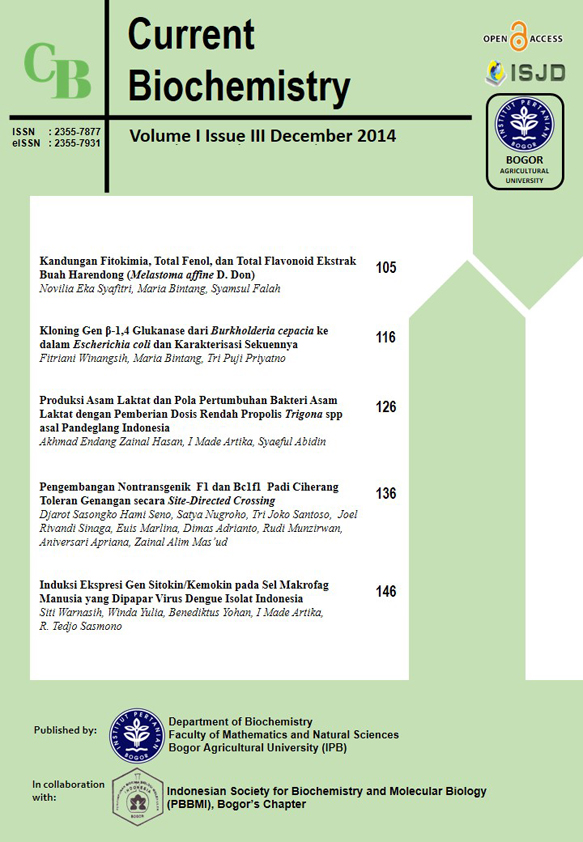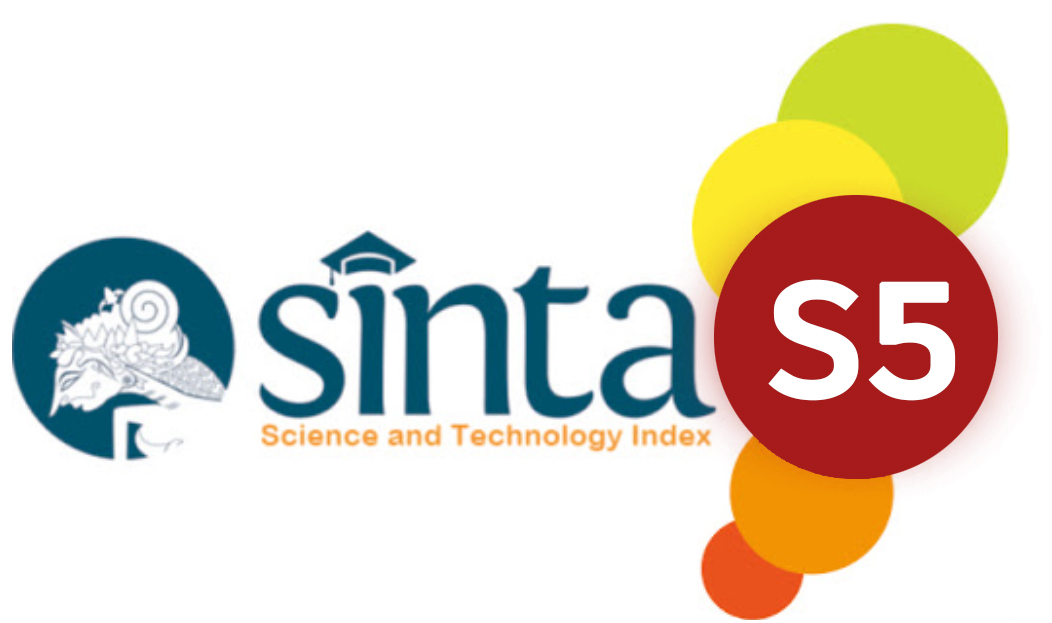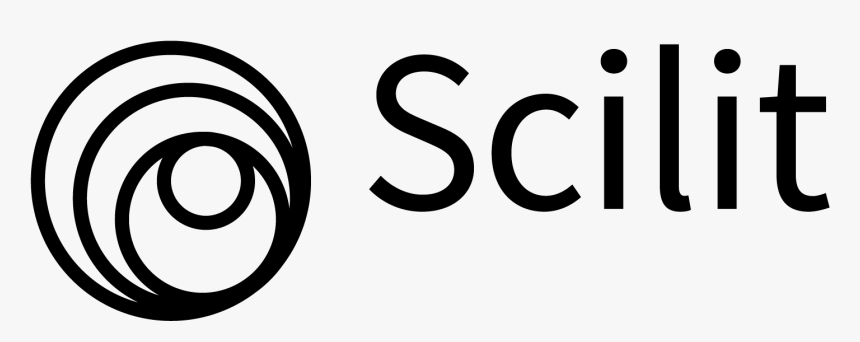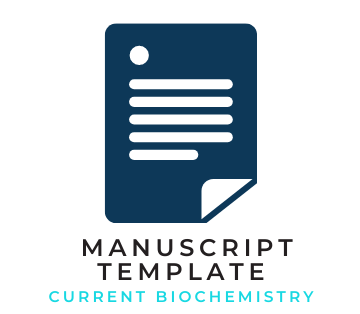Produksi Asam Laktat dan Pola Pertumbuhan Bakteri Asam Laktat dengan Pemberian Dosis Rendah Propolis <i>Trigona</i> spp asal Pandeglang Indonesia
Abstract
Propolis is known to have an antimicrobial activity and can prevent various diseases. Propolis consumption is feared to have negative impact on the activity of digestive lactid acid bacteria (LAB). The aim of this research was to examine the effect of propolis on the growth and lactic acid production of three LAB. Ethanol Extraction Propolis (EEP) concentrations examined were control, eep and X propolis 0% (control), 0.2%, 0.6%, 1.0% and X propolis at 0.4% concentration. The parameters analyzed were the growth of bacteria counted with Total Plate Count (TPC) method and lactic acid production using titrable acidity analysis. Propolis at 0,6% concentration stimulated the growth of Lactobacillus casei subsp. rhamnosus (LCR, 24.725x108 cell/mL), but inhibited the average lactic acid production (0.071%) lower than control (0,149%). Propolis did not affect the growth of Streptococcus thermophillus (STP), but propolis at 0,6% concentration stimulated lactic acid production (0.182%) higher than control (0.112%). Propolis inhibited the growth of Lactobacillus delbrueckii subsp. bulgaricus (LDB), but at 0,2% concentration, its population was still highest (3.775x108 cell/mL) and lactic acid production was stimulated (0.195%) higher than control (0.123%).
References
[AOAC] Association of Official Analytical Chemistry. 1995. Official Methods of Analysis. Washington
Bankova VS, de Castro SL, Marucci MC. 2000. Propolis: Recent advances in chemistry and plant origin. Apidol 31: 3-15.
Fatoni A. 2008. Pengaruh propolis Trigona spp. asal Bukit tinggi terhadap beberapa bakteri usus halus sapi dan penelusuran komponen aktifnya [tesis]. Bogor: Sekolah Pascasarjana, Institut Pertanian Bogor.
Fearnley J. 2001. Bee Propolis Natural Healing from The Hive. London: Souvenir Pr.
Greenaway W, Scaysbrook T, Whatley FR. 1990. The composition and plant origins of propolis: A report of work at Oxford. Bee World 71: 107–18.
Haddadin MSY, Nazer I, Abu Raddad SJ, Robinson RK. 2008. Effect of propolis on two bacterial species with probiotic potential. Pakist J Nutr 7: 391-394.
Hasan AEZ. 2006. Potensi propolis lebah madu Trigona spp. sebagai zat antimikrobial [laporan hasil penelitian]. Bogor: Lembaga Penelitian dan Pengabdian Masyarakat Institut Pertanian Bogor.
Kalogeropoulos N, Konteles S, Troullidou E, Mourtzinos I, Karathanos VT. 2009. Chemical composition, antioxidant activity and antimicrobial properties of propolis extracts from Greece and Cyprus. Food Chem. xxx (2009) xxx–xxx. (Artikel diperoleh dari Pengarang).
Kusnawati Y. 2004. Aktivitas protease susu pateurisasi yang ditambah Bifidobacterium bifidum pada berbagai waktu simpan [skripsi]. Bogor: Fakultas Matematika dan Ilmu Pengetahuan Alam, Institut Pertanian Bogor.
Marcucci MC. 1995. Propolis: chemical composition, biological properties and therapeutic activity. Apidol 26: 83–99.
Mitsuoka T. 1990. A Profile of Intestinal Bacteria. Tokyo: Yakult Honsha. Oxoid. 1980. The Oxoid Mannual of Culture Media, Ingredients, and Other Laboratory Practise. Ed ke-5. Basingtoke: Oxoid.
Monzote L, Cuesta-Rubio O, Fernandez MC, Hernandez IM, Fraga J, Perez K, Kerstens M, Maes L, Cos P. 2012. In vitro antimicrobial assessment of Cuban propolis extracts. Mem Inst Oswaldo Cruz. 107(8):978-984.
Pelczar MJJr, Chan ECS. 1988. Dasar-Dasar Mikrobiologi. Volume ke-1,2. Hadioetomo RS, Imas T, Tjitrosomo SS, Angka SL, penerjemah; Jakarta: UI Pr. Terjemahan dari: Elements of Microbiology.
Ramadzanti A. 2006. Aktivitas protease dan kandungan asam laktat pada yoghurt yang dimodifikasi Bifidobacterium bifidum [skripsi]. Bogor: Fakultas Matematika dan Ilmu Pengetahuan Alam, Institut Pertanian Bogor.
Sabir A. 2005a. Aktivitas antibakteri flavonoid propolis Trigona sp. Terhadap bakteri Streptococcus mutans (in vitro). Dent J 38: 135–141.
Sabir A. 2005b. Respons inflamasi pada pulpa gigi tikus setelah aplikasi ekstrak etanol propolis (EEP). Dent J 38: 77–83.
Sulminen S, Ouwehana A, Benno V, Lee YK. 1999. Probiotik: How Should They be Defined. Trend in Food Science and Technology. Ed ke-10. Norfolk: Horison Scientific Pr.
Tamime AY, Robinson RK. 2007. Yoghurt, Science, and Technology. Ed ke-3. New York: CRC Pr
Topping DL, Clifton PM. 2001. Short-chain fatty acids and human colonic function: Roles of resistant starch and non-starch polysaccharides. Physiol Rev 81: 1031-1064.
Toreti VC, Sato HH, Pastore GM, Park YK. 2013. Recent Progress of Propolis for Its Biological and Chemical Compositions and Its Botanical Origin. Evid Based Complement Alternat Med. Article ID 697390:13.
Tukan GD. 2008. Pengaruh propolis Trigonaspp asal Pandeglang terhadap beberapa isolat bakteri usus sapi dan penelusuran komponen aktifnya [tesis]. Bogor: Sekolah Pascasarjana, Institut Pertanian Bogor.
Walstra P, Geurts TJ, Noomen A, Jellema A, Boekel MAJS. 1999. Dairy Technology. Principless of Milk Properties and Processes. New York: Marcell Dekker.













